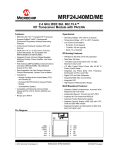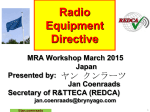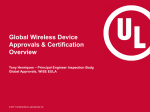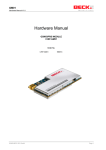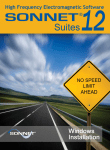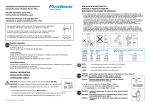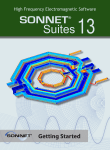Download Application note: Conformity Analysis and
Transcript
Application note: Conformity Analysis and Approval of the Beck WLAN – Module (WL01) As on: June 2007 The following implementations are specially related to applications using the Beck WL01 module and do not necessarily have universal validity. General Background (Germany / Europe) Radio-based equipment must comply with the requirements of the European R&TTE Guidelines 1999/5/EG (Radio Equipment & Telecommunications Terminal Equipment). The harmonized standards applied in the context of the declaration of conformity for the module WL01 are: Clause 3.1 a Î EN 60950-1 (Standard for ‚Security in Information Technology’) It must be ensured that the power supply to the module (Printed Circuit Board, PCB) is fed from a source of limited rating in accordance with clause 2.5 of the standard. The Instructions for Use of the module must be complied with (refer to the Hardware Manual). Clause 3.1 a Î EN 60950-1 (Standard for ‘Security in Information Technology’) It must be ensured that the power supply to the module (PCB) is fed from a source of limited rating in accordance with clause 2.5 of the standard. The Instructions for Use of the module must be complied with (refer to the Hardware Manual). Clause 3.1 a Î EN50371 (Standard for Health Safety ‘Information Technology’) (Compatibility with Electromagnetic Fields [EMF] / Electromagnetic Environment Capability [EMVU]) This standard is fulfilled automatically if less than 20mW of the transmitted power can be converted to heat. Either the manufacturer limits the transmission power to maximum 20mW (EIRP = effective isotropic radiated power) or the end equipment manufacturer ensures that the limit values of the EU recommendation 1999/519/EG are complied with. The compliance can be established with the help of the measurement of the specific absorption rate (SAR = Specific Absorption Rate), or, if the distance between human beings and the antenna is greater than 20 cm, by means of calculation of the electrical field strength. The User Manual must contain appropriate warnings to this effect. Clause 3.1b Î EN 301 489-17 (EMI/EMC) (Standard for electromagnetic compatibility and/or fault-free operation of electrical appliances with respect to their environment) Clause 3.2 Î EN 300 328 (effective utilization of the radio spectrum) This standard provides information regarding measurement rules and test procedures that serve to test the parameters of WLAN radio applications in the 2.4 GHz frequency range. The compliance with this standard (effective utilization of the frequency spectrum) must not be re-established by the equipment manufacturer so long as no other antenna is used. The existing measurements of the WLAN module are adequate. AN_WLAN_CONFORMITY_EN_V13.PDF © Beck IPC GmbH Beck IPC GmbH Grüninger Weg 24 35415 Pohlheim / Germany E-mail: [email protected] www.beck-ipc.com A member of the Festo group The following is applicable if the equipment manufacturer uses other antennas: If an end equipment manufacturer uses an antenna other than those recommended by Beck then the emitted power (EIRP) and the spurious emissions must be analyzed again. There are two options: 1. The other antennas match the technical data of those recommended by Beck. One can, as an analogy, accept the measurement results, but, however, there is still the risk that the maximum emission power in the side bands of the antenna frequency range is beyond the maximum permissible value. or 2. The other antennas must be subjected to fresh EMI/EMC tests in conjunction with the WLAN module. All these minimum requirements (3.1a, 3.1b, 3.2) must be fulfilled for WLAN devices. The technical requirements are also available in the harmonized standards. The equipment manufacturer must evaluate the clauses 3.1a and 3.1b afresh. The requirements of the Guidelines must be fulfilled prior to launching the product in the market. The clause 3.2 must not be assessed again. The specification of the EN 60950-1/A11: 2004 or the EN 60950-1:2001 standards (in clause 3.1a) is exemplary for devices pertaining to Information Technology. The corresponding appropriate standards must be used for devices of other industries (e.g. medical technology). Compliance with the Directives The Federal Network Agency verifies the compliance with the directives (and/or conducts market surveillance). The Federal Network Agency must have unlimited access to all information pertaining to the product in this connection for performing this task. These are: - The User Manual - All manufacturing documentation (block diagrams, circuit diagrams, component layout plan, layout, parts list) - Description of the functionality - All test reports for the standards to be complied with as per R+TTE (see page 1) - Conformity analysis - Declaration of Conformity This information must either be available directly with the equipment manufacturer or (as in the case of the Beck modules) they must be deposited with the ‘Notified Body’ (NB). Notified Body (NB) A Notified Body is an independent conformity assessment center. Technical documentation (Technical Construction File, TCF) is checked and assessed within the framework of this activity. The Notified Body can furnish the required documentation of the TCF’s to the Federal Network Agency in the context of market surveillance. A ‘normal’ (end) customer cannot request the NB for this documentation. AN_WLAN_CONFORMITY_EN_V13.PDF © Beck IPC GmbH Beck IPC GmbH Grüninger Weg 24 35415 Pohlheim / Germany E-mail: [email protected] www.beck-ipc.com A member of the Festo group Declaration of Conformity Note: The conformity declaration of the end product manufacturer is valid for the entire product without any constraints! Who or what is an equipment manufacturer? The equipment manufacturer is responsible for an entire device that uses the WL01. Declaration of Conformity Beck has prepared a declaration of conformity for this purpose as the marketing agency for the WL01. The equipment manufacturer, on his part, must also submit a declaration of conformity. This conformity declaration of the end equipment manufacturer is valid for the entire product without any constraints. This, however, applies only under the assumption that the antennas recommended by Beck have been used and that the recommended instructions for use have been complied with. Special Case Î The equipment manufacturer uses his own antennas: In this case, the equipment manufacturer must assess whether the antennas used by him are comparable (to those recommended by Beck) and whether it is necessary to conduct new tests as a result of using these antennas. Independent institutes can provide support for this purpose, for example, the ‘Phoenix Test Laboratory’ in Blomberg. Notifications Notification is intimation of the respective state authority in the EU about the intent of the marketing agency of a radio-based system in the member state. This requirement is stipulated in article 6.4 of the R&TTE Guidelines. The equipment manufacturer (‘Final Integrator’) must initiate the process of notification at least four weeks prior to bringing the equipment into the market. The notification is always made in the countries in which the module is launched in the market. The application for notification is lodged using the form specific to the respective country. There is no standard form applicable to the whole of Europe. In Germany, the notifications are issued to the Federal Network Agency. Even here, it is helpful to have the process of notification initiated by companies that are specialized in the provision of such services. Currently, the costs are approximately 100 Euros / European country. Existing notifications can be used as marketing instruments. Product Information “Beck” provides information about all relevant technical issues, which must be taken into consideration when integrating the WLAN module in the customer’s equipment (please refer to the Hardware Handbook). In addition, Beck also furnishes information regarding the tests that have already been carried out and makes the results of these tests available to the customer. However, the customer himself must decide about the analysis and/or decision regarding the additional tests to be conducted. Please also visit: www.rtteca.com AN_WLAN_CONFORMITY_EN_V13.PDF © Beck IPC GmbH Beck IPC GmbH Grüninger Weg 24 35415 Pohlheim / Germany E-mail: [email protected] www.beck-ipc.com A member of the Festo group General Background (USA) FCC Certification The requirements of the FCC are applicable for the certification in the USA, i.e. tests must be carried out and certification must be applied for in order to obtain the FCC certification. The application for certification can also be filed in Europe with a Telecommunication Certification Body (TCB). The successful issue of the FCC certification is documented with the help of a FCC number on the approved product. If this product is not the final product then this FCC number must, in any case, also be visible on the end product. The Beck WLAN module has an FCC certification. This is valid as long as those antennas that are recommended by Beck for use in the USA are deployed. If other antenna should be used in the USA then fresh FCC certification must be obtained. It is recommended that FCC certification should be obtained with the help of a service provider. General Background (Canada) An application must be lodged for approval in Canada. This can be applied for in Europe with a Foreign Certification Body (FCB). Canada is very similar to the USA with respect to approval and standards. The standard in Canada is called ‘IC’ and is approximately 95 % identical to the FCC, i.e. the claims made in the ‘USA’ are, by and large, also valid in Canada. Cost estimates for approval outside Europe / USA China: Japan: Bahamas: Approval approx. 10,000 € / Tests approx. 10,000 € in addition to costs for a local representative. Time required for approval under ideal conditions approx. 15 weeks. In Europe, approval for Japan can be applied for with a Registered Certification Body (RCB) (Tests and certification in Germany) Approval approx. 5,000 € / Tests approx. 4,000 € can only be performed in Japan Approval approx. 950 € Queries regarding the WLAN module What is the documentation that is provided by Beck for the customer? - The Technical Manual of the WL01 module with all instructions for appropriate use of the same - The conformity declaration for the WL01 module - Please enquire with the Beck Support Center ([email protected]) regarding the ‚Notified Body’ with which the documentation for the WL01 module has been filed - An exemplary sample of the FCC qualification of a product is available on the FCC website (ww.fcc.gov) What must an equipment manufacturer do in order to get his WL01-based product approved in Europe? - The equipment manufacturer must perform a complete conformity analysis for his product - The equipment manufacturer must ensure that all R&TTE standards listed above have been complied with. For this purpose, it is also necessary that a fresh analysis be carried out for the end product. - The equipment manufacturer must know the ‘Notified Body’ with which the technical documentation of the WL01 module has been filed, so that they are available for market surveillance. The customer himself is responsible for filing the remaining documentation - The equipment manufacturer must prepare a conformity declaration for his device/product - The equipment must be notified separately in the respective countries. Note: The equipment manufacturer is entirely responsible for his complete product including the WL01 module. AN_WLAN_CONFORMITY_EN_V13.PDF © Beck IPC GmbH Beck IPC GmbH Grüninger Weg 24 35415 Pohlheim / Germany E-mail: [email protected] www.beck-ipc.com A member of the Festo group What must an equipment manufacturer do in order to get his device/product approved in the USA? - The FCC number of the WL01 module must be visible on the end device - Only those antennas listed in the FCC approval of the WL01 module may be used. Other antennas require a new FCC certification in connection with the WL01 module - Notification in the USA is not required since all necessary approvals and notifications are covered by the FCC certification. The manufacturer must analyze the requirements of the FCC with respect to the end device. If required, further certification may be necessary. - The customer is not entirely responsible for his overall product; the responsibility for the WL01 module continues to remain with Beck Do the in-built pigtails (antenna adapter) have an effect on the certification of a device? - Europe: Yes, a new analysis must be carried out for the complete device. - USA: Only those pigtails are permitted that have been approved by the FCC certification in connection with the WL01 module (refer to the recommendation by Beck) The WL01 modules are supplied without an antenna. What does one need to consider when selecting the antenna? - The EN 300 328 standards must be complied with - The maximum permissible transmission power must be taken into consideration (for example, there is a statutory limit on this in Germany. This is 100mW (20dBm) EIRP in the WLAN frequency range - Recommended by Beck: Use the antenna specified for the WL01 module - If a customer desires to use an antenna other than those recommended by Beck then he must carry out a new analysis of this combination himself. If a device having a specific antenna has been certified, may it only be sold with this antenna? Germany / Europe: Basically, in Germany, other antennas may be used as long as the permissible transmission power, particularly taking the emission characteristics and the limits of the spurious emissions into account, are not exceeded. USA: Only those devices that have been completely certified by the FCC (WL01 with antenna connected) may be used in the USA. In order to prevent the use of other antennas by users who are not adequately qualified, the FCC approves only fixed networks with ‘unique’ connectors that are not available in the retail market. What does one have to take into account when using one’s own antenna design and construction? Basically, it is permitted to have one’s own antenna design and construction. It is necessary to obtain a new approval. Links www.rtteca.com www.fcc.gov AN_WLAN_CONFORMITY_EN_V13.PDF © Beck IPC GmbH Beck IPC GmbH Grüninger Weg 24 35415 Pohlheim / Germany E-mail: [email protected] www.beck-ipc.com A member of the Festo group







